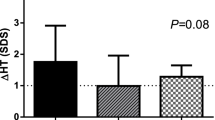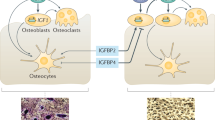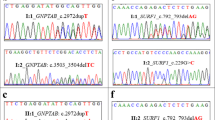Abstract
Desbuquois dysplasia type 2 (DBQD2) is a rare recessively inherited skeletal genetic disorder characterized by severe prenatal and postnatal growth retardation, generalized joint laxity with dislocation of large joints and facial dysmorphism. The condition was recently described to result from autosomal recessive mutations in XYLT1, encoding the enzyme xylosyltransferase-1. In this paper, we report on a Polish patient with DBQD2 who presented with severe short stature of prenatal onset, joint laxity, psychomotor retardation and multiple radiological abnormalities including short metacarpals, advanced bone age and exaggerated trochanters. Endocrinological examinations revealed that sleep-induced growth hormone (GH) release and GH peak in clonidine- and glucagon-induced provocative tests as well as insulin-like growth factor 1 (IGF-1) and IGF-binding protein-3 levels were all markedly decreased, confirming deficiency of GH secretion. Bone age, unlikely to GH deficiency, was significantly advanced. To establish the diagnosis at a molecular level, we performed whole-exome sequencing and bioinformatic analysis in the index patient, which revealed compound heterozygous XYLT1 mutations: c.595C>T(p.Gln199*) and c.1651C>T(p.Arg551Cys), both of which are novel. Sanger sequencing showed that the former mutation was inherited from the healthy mother, whereas the latter one most probably occurred de novo. Our study describes the first case of DBQD2 resulting from compound heterozygous XYLT1 mutation, expands the mutational spectrum of the disease and provides evidence that the severe growth retardation and microsomia observed in DBQD2 patients may result not only from the skeletal dysplasia itself but also from GH and IGF-1 deficiency.
Similar content being viewed by others
Log in or create a free account to read this content
Gain free access to this article, as well as selected content from this journal and more on nature.com
or
References
Warman, M. L., Cormier-Daire, V., Hall, C., Krakow, D., Lachman, R., LeMerrer, M. et al. Nosology and classification of genetic skeletal disorders: 2010 revision. Am. J. Med. Genet 155A, 943–968 (2011).
Desbuquois, G., Grenier, B., Michel, J. & Rossigno, C. Nanisme chondrodystrophique avec ossification anarchique et polymalformations chez deux soeurs. Arch. Franc. Pediat. 23, 573–587 (1966).
Faivre, L., Le Merrer, M., Al-Gazali, L. I., Ausems, M. G., Bitoun, P., Bacq, D. et al. Homozygosity mapping of a Desbuquois dysplasia locus to chromosome 17q25.3. J. Med. Genet. 40, 282–284 (2003).
Faivre, L., Cormier-Daire, V., Eliott, A. M., Field, F., Munnich, A., Maroteaux, P. et al. Desbuquois dysplasia, a reevaluation with abnormal and normal hands: radiographic manifestations. Am. J. Med. Genet. 124 A, 48–53 (2003).
Huber, C., Oulès, B., Bertoli, M., Chami, M., Fradin, M., Alanay, Y. et al. Identification of CANT1 mutations in desbuquois dysplasia. Am. J. Med. Genet. 85, 706–710 (2009).
Kim, O. H., Nishimura, G., Song, H. R., Matsui, Y., Sakazume, S., Yamada, M. et al. A variant of Desbuquois dysplasia characterized by advanced carpal bone age, short metacarpals, and elongated phalanges: report of seven cases. Am. J. Med. Genet. A 152 A, 875–885 (2010).
Furuichi, T., Dai, J., Cho, T. J., Sakazume, S., Ikema, M., Matsui, Y. et al. CANT1 mutation is also responsible for Desbuquois dysplasia, type 2 and Kim variant. J. Med. Genet. 48, 32–37 (2011).
Bui, C., Huber, C., Tuysuz, B., Alanay, Y., Bole-Feysot, C., Leroy, J. G. et al. XYLT1 mutations in Desbuquois dysplasia type 2. Am. J. Hum. Genet. 94, 405–414 (2014).
Prydz, K. & Dalen, K. T. Synthesis and sorting of proteoglycans. J. Cell. Sci. 113 (Part 2), 193–205 (2000).
Voglmeir, J., Voglauer, R. & Wilson, I. B. XT-II, the second isoform of human peptide-O-xylosyltransferase, displays enzymatic activity. J. Biol. Chem 282, 5984–5990 (2007).
Hästbacka, J., de la Chapelle, A., Mahtani, M. M., Clines, G., Reeve-Daly, M. P. & Daly, M. The diastrophic dysplasia gene encodes a novel sulfate transporter: positional cloning by fine-structure linkage disequilibrium mapping. Cell 23, 1073–1087 (1994).
Unger, S., Lausch, E., Rossi, A., Mégarbané, A., Sillence, D., Alcausin, M. et al. Phenotypic features of carbohydrate sulfotransferase 3 (CHST3) deficiency in 24 patients: congenital dislocations and vertebral changes as principal diagnostic features. Am. J. Med. Genet. A 152 A, 2543–2549 (2010).
Zhang, D., Herring, J. A., Swaney, S. S., McClendon, T. B., Gao, X., Browne, R. H. et al. Mutations responsible for Larsen syndrome cluster in the FLNB protein. J. Med. Genet. 43, e24 (2006).
Vissers, L. E., Lausch, E., Unger, S., Campos-Xavier, A. B., Gilissen, C., Rossi, A. et al. Chondrodysplasia and abnormal joint development associated with mutations in IMPAD1, encoding the Golgi-resident nucleotide phosphatase, gPAPP. Am. J. Hum. Genet. 88, 608–615 (2011).
Greulich, W. W. & Pyle, S. I. Radiographic Atlas of Skeletal Development of the Hand and Wrist, 2n edn (Stanford University Press, Stanford, CA, USA, 1959).
Robinson, P. N., Kohler, S., Bauer, S., Seelow, D., Horn, D. & Mundlos, S. The Human Phenotype Ontology: a tool for annotating and analyzing human hereditary disease. Am. J. Hum. Genet. 83, 610–615 (2008).
Köhler, S., Doelken, S. C., Mungall, C. J., Bauer, S., Firth, H. V. et al. The Human Phenotype Ontology project: linking molecular biology and disease through phenotype data. Nucleic Acids Res. 42, D966–D974 (2014).
Zemojtel, T., Köhler, S., Mackenroth, L., Jäger, M., Hecht, J. & Krawitz, P. et al. Effective diagnosis of genetic disease by computational phenotype analysis of the disease-associated genome. Sci Transl Med 6, 252ra123 (2014).
Schwarz, J. M., Cooper, D. N., Schuelke, M. & Seelow, D. MutationTaster2: mutation prediction for the deep-sequencing age. Nat. Methods. 11, 361–362 (2014).
Adzhubei, I. A., Schmidt, S., Peshkin, L., Ramensky, V. E., Gerasimova, A., Bork, P. et al. A method and server for predicting damaging missense mutations. Nat. Methods 7, 248–249 (2010).
SIFT. Available at: http://sift.jcvi.org/ Accessed 5 January 2016.
Kircher, M., Witten, D. M., Jain, P., O'Roak, B. J., Cooper, G. M. & Shendure, J. A general framework for estimating the relative pathogenicity of human genetic variants. Nat. Genet. 46, 310–315 (2014).
The 1000 Genomes Project. Available at: http://www.1000genomes.org/ Accessed 5 January 2016.
The Database of Short Genetic Variation (dbSNP). National Center for Biotechnology Information. Available at: http://www.ncbi.nlm.nih.gov/projects/SNP/snp_summary.cgi Accessed 5 January 2016.
The Human Gene Mutation Database. Available at: http://www.hgmd.cf.ac.uk/ac/index.php Accessed 5 January 2016.
NHLBI Exome Sequencing Project (ESP) Exome Varian Server (EVS). Available at: http://evs.gs.washington.edu/EVS/ Accessed 5 January 2016.
The Exome Aggregation Consortium (ExAC). Available at: http://exac.broadinstitute.org/ Accessed 5 January 2016.
Schreml, J., Durmaz, B., Cogulu, O., Keupp, K., Beleggia, F., Pohl, E. et al. The missing "link": an autosomal recessive short stature syndrome caused by a hypofunctional XYLT1 mutation. Hum. Genet. 133, 29–39 (2014).
Mis, EK, Liem, KF Jr, Kong, Y, Schwartz, NB, Domowicz, M & Weatherbee, SD Forward genetics defines Xylt1 as a key, conserved regulator of early chondrocyte maturation and skeletal length. Dev. Biol. 385, 67–82 (2014).
Acknowledgements
We are grateful to the patients for participating in this study. This work was supported by a grant from the National Center for Research and Development (LIDER/008/431/L-4/12/NCBR/2013) and by a grant from the Polish National Science Centre (UMO-2011-03-B-NZ5-00510) (to AJ).
Author information
Authors and Affiliations
Corresponding author
Ethics declarations
Competing interests
The authors declare no conflict of interest.
Rights and permissions
About this article
Cite this article
Jamsheer, A., Olech, E., Kozłowski, K. et al. Exome sequencing reveals two novel compound heterozygous XYLT1 mutations in a Polish patient with Desbuquois dysplasia type 2 and growth hormone deficiency. J Hum Genet 61, 577–583 (2016). https://doi.org/10.1038/jhg.2016.30
Received:
Revised:
Accepted:
Published:
Issue date:
DOI: https://doi.org/10.1038/jhg.2016.30
This article is cited by
-
Novel compound heterozygous variants in XYLT1 gene caused Desbuquois dysplasia type 2 in an aborted fetus: a case report
BMC Pediatrics (2022)
-
Further phenotypic delineation of the auriculocondylar syndrome type 2 with literature review
Journal of Applied Genetics (2021)
-
Novel and recurrent XYLT1 mutations in two Turkish families with Desbuquois dysplasia, type 2
Journal of Human Genetics (2017)



